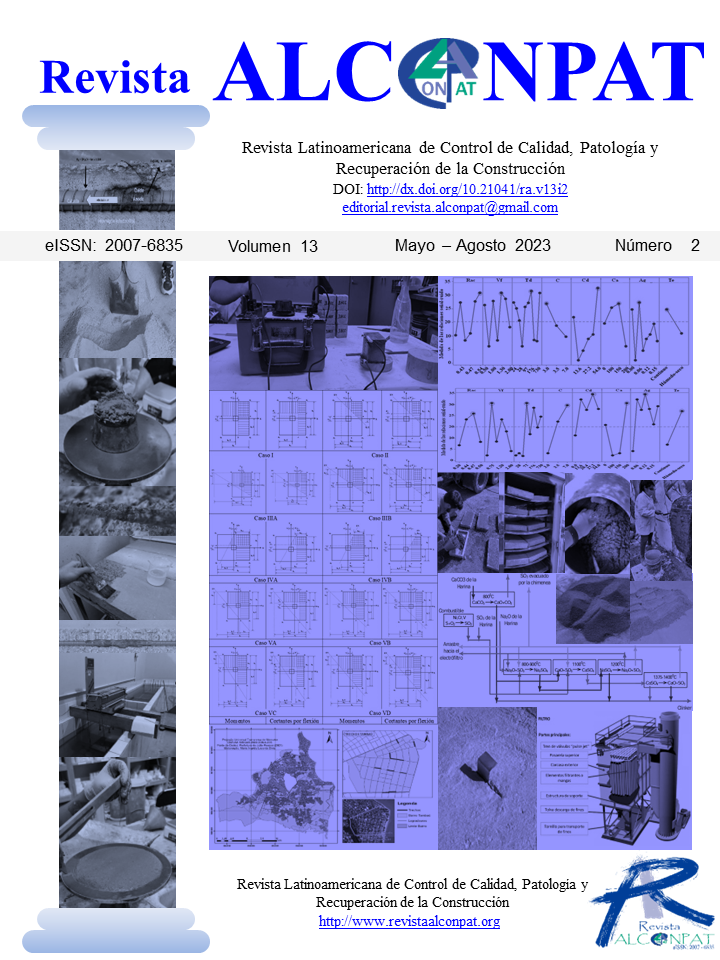Influence of sand proportion in the physical and mechanical properties of construction and building mortars
DOI:
https://doi.org/10.21041/ra.v13i2.684Keywords:
construction mortars, electrical resistivity, fine aggregates, mechanical resistance, sieve analysisAbstract
The influence of sand proportion of in mortars Type II was studied according to the standard N-CMT-2-01-004/02. Three different types of fine aggregates from the region of Morelia, in Michoacan, were used to determine their influence in the physical and mechanical properties. Different cementitious materials (CM): Portland cement plus lime (B1), and Portland cement plus construction cement (B2) were considered and mixed. The mortar mixtures were designed for B1 and B2 with different volume ratios of aggregates/CM, from 2.25 to 4. The characterization determined the fluency, the uniaxial compressive strength (UCS) and the wet electrical resistivity (WER). Analyzing the fluency and the ratio water/CM it was concluded that the aggregate properties and their proportions modify the water demand in the fresh state of the mortar and consequently the UCS and WER.
Downloads
References
Álvarez Galindo, J. I., Martín Pérez, A., García Casado, P. J. (1995). Historia de los morteros. Revista PH, 13, 52. https://doi.org/10.33349/1995.13.263
ASTM International. (2017). ASTM C29/C29M 17a. Standard Test Method for Bulk Density (“Unit Weight”) and Voids in Aggregate. ASTM International.
ASTM International. (2018). ASTM C33-C33M-18. Standard Specification for Concrete Aggregates. ASTM International. https://doi.org/10.1520/C0033_C0033M-18
ASTM International. (2019a). ASTM C1876-19. Standard Test Method for Bulk Electrical Resistivity or Bulk Conductivity of Concrete. ASTM International. https://doi.org/10.1520/C1876-19
ASTM International. (2019b). ASTM D75/D75M-19. Standard Practice for Sampling Aggregates. ASTM International.
ASTM International. (2020a). ASTM C305-20. Standard Practice for Mechanical Mixing of Hydraulic Cement Pastes and Mortars of Plastic Consistency. ASTM International. https://doi.org/10.1520/C0305-20
ASTM International. (2020b). ASTM E1266-20. Standard Practice for Processing Mixtures of Lime, Fly Ash, and Heavy Metal Wastes in Structural Fills and Other Construction Applications. ASTM International. https://doi.org/10.1520/E1266-20
ASTM International. (2021). ASTM C109/C109M-21. Standard Test Method for Compressive Strength of Hydraulic Cement Mortars (Using 2-in. or [50 mm] Cube Specimens). ASTM International. https://doi.org/10.1520/C0109_C0109M-21
ASTM International. (2022a). ASTM C31/C31M-22. Standard Practice for Making and Curing Concrete Test Specimens in the Field. ASTM International. https://doi.org/10.1520/C0031_C0031M-22
ASTM International. (2022b). ASTM C128-22. Standard Test Method for Relative Density (Specific Gravity) and Absorption of Fine Aggregate. ASTM International.
ASTM International. (2022c). ASTM C150-C150M-22. Standard Specification for Portland Cement. ASTM International. https://doi.org/10.1520/C0150-07
Beng Wei, C., Othman, R., Yee Ying, C., Putra Jaya, R., Shu Ing, D., Ali Mangi, S. (2021). Properties of mortar with fine eggshell powder as partial cement replacement. Materials Today: Proceedings, 46, 1574–1581. https://doi.org/10.1016/j.matpr.2020.07.240
Brazão Farinha, C., de Brito, J., Veiga, R. (2021). Incorporation of high contents of textile, acrylic and glass waste fibres in cement-based mortars. Influence on mortars’ fresh, mechanical and deformability behaviour. Construction and Building Materials, 303, 124424. https://doi.org/10.1016/j.conbuildmat.2021.124424
Danish, A., Ozbakkaloglu, T. (2023). Impact of nano-silica on the mechanical properties of mortar containing e-waste plastic as fine aggregates. Materials Today: Proceedings. https://doi.org/10.1016/j.matpr.2023.03.182
Durán Ramos, A. M. (2021). Diseño de mezclas plásticas aglomerantes y su consideración de proporcionamiento por medio del ensayo de fluidez (Bachelor’s Degree Thesis). Universidad Michoacana de San Nicolás de Hidalgo.
Gao, X., Yao, X., Xie, R., Li, X., Cheng, J., Yang, T. (2022). Performance of fly ash-based geopolymer mortars with waste cathode ray tubes glass fine aggregate: A comparative study with cement mortars. Construction and Building Materials, 344, 128243. https://doi.org/10.1016/j.conbuildmat.2022.128243
Giordani, C., Masuero, A. B. (2019). Blended mortars: Influence of the constituents and proportioning in the fresh state. Construction and Building Materials, 210, 574–587. https://doi.org/10.1016/j.conbuildmat.2019.02.077
Haach, V. G., Vasconcelos, G., Lourenço, P. B. (2011). Influence of aggregates grading and water/cement ratio in workability and hardened properties of mortars. Construction and Building Materials, 25(6), 2980–2987. https://doi.org/10.1016/j.conbuildmat.2010.11.011
Hafid, H., Ovarlez, G., Toussaint, F., Jezequel, P. H., Roussel, N. (2016). Effect of particle morphological parameters on sand grains packing properties and rheology of model mortars. Cement and Concrete Research, 80, 44–51. https://doi.org/10.1016/j.cemconres.2015.11.002
Hammat, S., Menadi, B., Kenai, S., Thomas, C., Kirgiz, M. S., Sousa Galdino, A. G. de. (2021). The effect of content and fineness of natural pozzolana on the rheological, mechanical, and durability properties of self-compacting mortar. Journal of Building Engineering, 44, 103276. https://doi.org/10.1016/j.jobe.2021.103276
Hu, J. (2005). A study of effects of aggregate on concrete rheology [Iowa State University, Digital Repository]. https://doi.org/10.31274/rtd-180813-15380
Jacques, K. T. J., Zengyao, W., Shoude, W., Shifeng, H., Xin, C. (2023). The influence of different fine aggregate and cooling regimes on the engineering properties of sulphoaluminate cement mortar after heating. Case Studies in Construction Materials, 18, e01866. https://doi.org/10.1016/j.cscm.2023.e01866
Li, T., Nogueira, R., de Brito, J., & Liu, J. (2023). Underlying mechanisms of the influence of fine aggregates’ content and properties on mortar’s plastic viscosity. Journal of Building Engineering, 67, 106016. https://doi.org/10.1016/j.jobe.2023.106016
Li, T., Zhou, Y., Zhu, J., Liu, J. (2022). Effect of fine aggregate gradation on the rheology of mortar. Construction and Building Materials, 332, 127362. https://doi.org/10.1016/j.conbuildmat.2022.127362
Martinez-Molina, W., Chavez-Garcia, H. L., Perez-Lopez, T., Alonso-Guzman, E. M., Arreola-Sanchez, M., Navarrete-Seras, M. A., Borrego-Perez, J. A., Sanchez-Calvillo, A., Guzman-Torres, J. A., Perez-Quiroz, J. T. (2021). Effect of the Addition of Agribusiness and Industrial Wastes as a Partial Substitution of Portland Cement for the Carbonation of Mortars. Materials, 14(23), 7276. https://doi.org/10.3390/ma14237276
Navarro-Mendoza, E. G., Alonso-Guzman, E. M., Ruvalcaba-Sil, J. L., Sánchez-Calvillo, A., Martínez-Molina, W., García, H. L. C., Bedolla-Arroyo, J. A., Becerra-Santacruz, H., Borrego-Pérez, J. A. (2020). Compressive strength and ultrasonic pulse velocity of mortars and pastes, elaborated with slaked lime and high purity hydrated lime, for restoration works in Mexico. In Key Engineering Materials: Vol. 862 KEM. https://doi.org/10.4028/www.scientific.net/KEM.862.51
Navarro-Mendoza, E. G., Alonso-Guzman, E. M., Sanchez-Calvillo, A., Bedolla-Arroyo, J. A., Becerra-Santacruz, H., Navarro-Ezquerra, A., Gonzalez-Sanchez, B., Martinez-Molina, W. (2023). Physical and Mechanical Characterization of Lime Pastes and Mortars for Use in Restoration. Heritage, 6(3), 2582–2600. https://doi.org/10.3390/heritage6030136
ONNCCE. (2004). NMX-C-073-ONNCCE-2004. Industria de la construcción - Agregados - Masa volumétrica. Método de prueba. Organismo Nacional de Normalización y Certificación de la Construcción y Edificación.
ONNCCE. (2006). NMX-C-084-ONNCCE-2006. Industria de la construcción - Agregados para Concreto - Partículas más Finas que la Criba 0,075 mm (No. 200) por Medio de Lavado – Método de Prueba. Organismo Nacional de Normalización y Certificación de la Construcción y Edificación.
ONNCCE. (2014). NMX-C-486-ONNCCE-2014. Industria de la construcción-Mampostería - Mortero para uso estructural- especificaciones y métodos de ensayo. Organismo Nocional de Normalización y Certificación de la Construcción y la Edificación.
ONNCCE. (2015a). NMX-C-061-ONNCCE-2015. Building Industry – Hydraulic Cements – Determination of Compressive Strength of Hydraulic Cements. Organismo Nacional de Normalización y Certificación de la Construcción y Edificación.
ONNCCE. (2015b). NMX-C-144-ONNCCE-2015. Building Industry - Hydraulic Cement - Specifications for the Apparatus used in the Flow Test for Mortars made of Hydraulic Cements. Organismo Nacional de Normalización y Certificación de la Construcción y Edificación.
ONNCCE. (2019). NMX-C-514-ONNCCE-2019. Building Industry – Electrical Resistivity of Hydraulic Concrete - Specifications and Testing Methods. Organismo Nacional de Normalización y Certificación de la Construcción y Edificación.
ONNCCE. (2020). NMX-C-165-ONNCCE-2020. Industria de la construcción - Agregados para concreto - Determinación de la reactividad potencial. Organismo Nacional de Normalización y Certificación de la Construcción y Edificación.
ONNCCE. (2002). N-CMT-2-01-004/02. Characteristics of Materials. Materials For Structures. Materials For Hydraulic Concrete. Organismo Nacional de Normalización y Certificación de la Construcción y Edificación.
Ren, Q., Tao, Y., Jiao, D., Jiang, Z., Ye, G., De Schutter, G. (2021). Plastic viscosity of cement mortar with manufactured sand as influenced by geometric features and particle size. Cement and Concrete Composites, 122, 104163. https://doi.org/10.1016/j.cemconcomp.2021.104163
Ribeiro, D. V., Oliveira Rey, R. (2019). Avaliação dos agregados utilizados na região metropolitana de Salvador quanto à ocorrência de Reatividade Álcalis-Agregado (RAA). Revista ALCONPAT, 9(2), 185–199. https://doi.org/10.21041/ra.v9i2.326
Sánchez Tizapa, S., Villaseñor Franco, A., Guinto Herrera, E., Barragán Trinidad, R., Mebarki, A. (2017). Propuesta de valores de referencia para la resistencia de diseño a compresión diagonal y compresión de la mampostería en el estado de Guerrero, México. Revista ALCONPAT, 7(3), 231–246. https://doi.org/10.21041/ra.v7i3.159
Senff, L., Barbetta, P. A., Repette, W. L., Hotza, D., Paiva, H., Ferreira, V. M., Labrincha, J. A. (2009). Mortar composition defined according to rheometer and flow table tests using factorial designed experiments. Construction and Building Materials, 23(10), 3107–3111. https://doi.org/10.1016/j.conbuildmat.2009.06.028
Souza, A. T., Barbosa, T. F., Riccio, L. A., Santos, W. J. dos. (2020). Effect of limestone powder substitution on mechanical properties and durability of slender precast components of structural mortar. Journal of Materials Research and Technology, 9(1), 847–856. https://doi.org/10.1016/j.jmrt.2019.11.024
Stolz, C. M., Masuero, A. B. (2018). Influence of grain distribution on the rheological behavior of mortars. Construction and Building Materials, 177, 261–271. https://doi.org/10.1016/j.conbuildmat.2018.05.131
Tena, A., Liga, A., Pérez, A., González, F. (2017). Proposal for improved mixes to produce concrete masonry units with commonly used aggregates available in the Valley of Mexico. Revista ALCONPAT, 7(1), 36–56. https://doi.org/10.21041/ra.v7i1.170
Ullah, Z., Qureshi, M. I., Ahmad, A., Khan, S. U., Javaid, M. F. (2021). An experimental study on the mechanical and durability properties assessment of E-waste concrete. Journal of Building Engineering, 38, 102177. https://doi.org/10.1016/j.jobe.2021.102177
Westerholm, M., Lagerblad, B., Silfwerbrand, J., Forssberg, E. (2008). Influence of fine aggregate characteristics on the rheological properties of mortars. Cement and Concrete Composites, 30(4), 274–282. https://doi.org/10.1016/j.cemconcomp.2007.08.008
Wu, M., Zhao, Q., Shen, W., Zhao, J., Xu, G., Zhao, D., Xiong, X. (2021). Mix design of self-leveling mortar prepared by crushed sand with high flowability and early strengthening. Construction and Building Materials, 283, 122679. https://doi.org/10.1016/j.conbuildmat.2021.122679
Downloads
Published
How to Cite
Issue
Section
License
_______________________________
License in effect from September 2020
You are free to:
- Share — copy and redistribute the material in any medium or format for any purpose, even commercially.
- Adapt — remix, transform, and build upon the material for any purpose, even commercially.
- The licensor cannot revoke these freedoms as long as you follow the license terms.
Under the following terms:
- Attribution — You must give appropriate credit , provide a link to the license, and indicate if changes were made . You may do so in any reasonable manner, but not in any way that suggests the licensor endorses you or your use.
- No additional restrictions — You may not apply legal terms or technological measures that legally restrict others from doing anything the license permits.
Notices:
You do not have to comply with the license for elements of the material in the public domain or where your use is permitted by an applicable exception or limitation .
No warranties are given. The license may not give you all of the permissions necessary for your intended use. For example, other rights such as publicity, privacy, or moral rights may limit how you use the material.





















.png)














